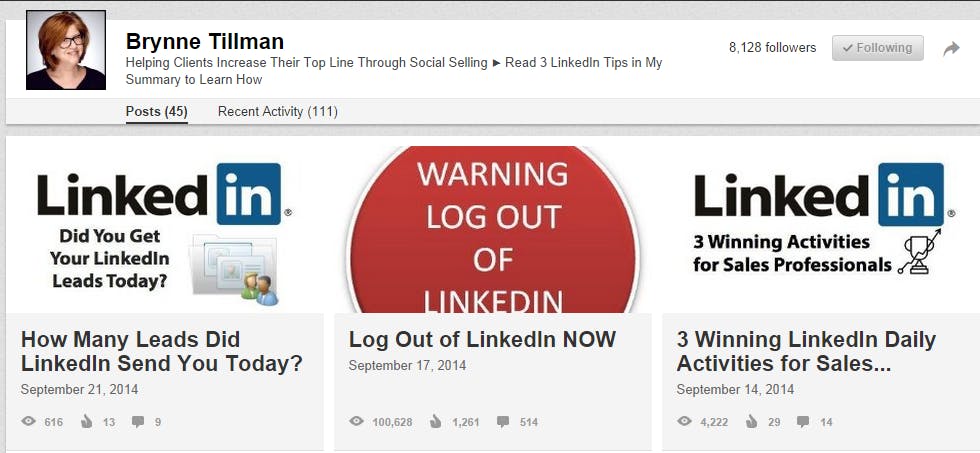For the longest time, Tiffany Jana never considered LinkedIn as a platform that had any significant impact on her business. She used it, sure, just as she was active on other networks like Twitter, but mainly as a casual user rather than treating it as an ancillary part of her business.
“It started as a childish competition between me and a colleague who owns a small business,” she told me in a phone interview. “And he was on this rampage of trying to friend everyone under the sun. Every time he did a speaking event, it was like friend all the people! And he got over 500 connections, and I was like I’m going to see what’s the point of doing this, so I started to friend all the people at every speaking event. I added the LinkedIn button to all my stuff, and I amassed an audience very quickly.”
But what to do with that audience? Jana eventually discovered LinkedIn Groups and began to join in on discussions within her field. But even as she spent an increasing about of time on the platform, she didn’t consider LinkedIn to be a tool that contributed to her bottom line. She’s the owner of a consulting company that works with organizations looking to increase the diversity of their workforce or adapt their HR policies to be more inclusive, and most of her business has been completely organic (through word of mouth and referrals) rather than derived from an organized marketing campaign.
But then Jana hired a branding company to work under a retainer to work for her business, and one of its tasks was to conduct a Web analytics audit for her website and social media properties. “It was at that point I discovered LinkedIn was my most engaged platform,” she said. “Liking, commenting, interaction, everything. There was more traffic being driven to my website from LinkedIn. There were more people commenting to my blog from LinkedIn. The interaction that was happening on my [social media] posts, it was happening far more on LinkedIn than anywhere else. That was the big moment where I realized, oh, I should probably pay a bit more attention to this.”
And then earlier this year Jana received an email from LinkedIn informing her she was part of a selected group of users who were invited to use its blogging tool. It was a spinoff of a platform launched in 2012 called LinkedIn Influencers. A small group of 150 major policy and company leaders—Bill Gates, Barack Obama, Richard Branson—had been invited to write blog posts for LinkedIn, which were then promoted via the company’s highly trafficked LinkedIn Today news feed. Each post garnered an average of 20,000 views, with some reaching up to the hundreds of thousands.
Last February, LinkedIn announced that it was allowing access to this blogging platform for all users, starting with an initial 25,000 active users and branching out from there. Once you opted in to the program, you could start penning longform blog posts with headlines, hyperlinks, and photos. New blog posts would appear on your profile page and you could discover your connections’ blog posts by visiting your LinkedIn home page. LinkedIn also made a significant change to its ecosystem by allowing users to “follow” other users without requiring them to follow back, a feature that was popularized by Twitter and has been rolled out by other major social networks.
“It was an answer to my prayers. This leveled the playing field for everyone.”
While the tech press covered the announcement, few reporters latched on to the significance of this move within the world of major social networks. A benefit from the rise of social platforms like Facebook and Twitter is that it converted millions of casual Web users into publishers, vastly expanding the blogosphere. But even though social networks offered a steady readership and easy use, they also, as I’ve argued previously, taken away control of how our content is presented. Facebook status updates don’t have headlines. You can’t use hyperlinks. You have no control over how your images are presented within that content. Because of this, anything over a few hundred characters isn’t ideal for the platform. Twitter, with its 140 character limit, is even more restrictive.
LinkedIn’s blogging tool offers features that you’ll be able to find on any WordPress blog. Posts contain headlines, have no character limits, allow hyperlinks, and let users position images any way they want within the content. Other than perhaps Tumblr, none of the other major social networking companies offer a publishing platform this robust. Though LinkedIn didn’t respond to my request for comment, Ryan Roslansky, head of content products at LinkedIn, gave some indication in February as to why the company made this move. “We do this because we want LinkedIn to be the place where members can become productive, successful professionals – not just when you’re trying to find a job, or search for another person.”
Journalists and analysts have long recognized that LinkedIn users, while numerous, typically don’t engage with the site except when they’re looking for a job; the blogging tool is a way of luring more of them into becoming regular visitors.
It had just this sort of effect on Tiffany Jana. When she first got the invite to begin blogging she initially ignored it. But then she noticed that more and more people that she admired—professionals who usually contributed blog posts to outlets like Fast Company and Inc—had published content that was showing up in her feed. “I was like, ‘Is this that same thing they invited me to do?’ And I went back and looked through my email, and there it was. So I tested it out the first time. My father later sent me a screenshot of his phone; I was right there next to Richard Branson, and that was the first recommendation on his Pulse.” From there forward, Jana was hooked.
This lightbulb effect, where business professionals went from casual users of LinkedIn to regular publishers seemingly overnight, was a common refrain among the people I interviewed. It happened to Karim Abouelnaga, who runs a startup that offers summer school programs in inner city neighborhoods. In August he was struck with an idea after he read an article that Wall Street firms were boosting take-home pay in order to halt its best employees from decamping to Silicon Valley. “I realized that wasn’t the reason people were leaving and I had all these different ideas for why they were,” he told me. “I jotted my ideas on a bus ride one day and then literally Sunday morning sat down and wrote the post. It maybe took me an hour.”
Though he already wrote regularly for Entrepreneur, Abouelnaga had been meaning to try out LinkedIn’s blog platform and decided to publish his piece there. “It pretty much went viral,” he recalled. “I posted it on my Facebook and maybe picked up like 10 likes, meaning the average person on my newsfeed didn’t care to read it. And then I saw that it had about 2,000 views on LinkedIn, and then it got reposted on a channel.”
LinkedIn channels are broad-based topics areas that users can subscribe to, and having your post published to a channel can expose it to a much larger audience. “Then people started commenting, tweeting, sharing. I think I got over 1,300 or 1,400 profile views.” The post itself has close to 46,000 views to date.
Brynne Tillman, who runs a business that consults with professionals and companies on their LinkedIn strategies, explained to me the game-changing dynamics of LinkedIn’s publishing tools. “I’d go in and teach an entire class, and none of them had the ability to blog on their company website, and it was very tedious to set up a WordPress or a Blogger site.” Tillman was one of the early beta testers of LinkedIn’s blog software, and right away she grasped its significance.
“It was an answer to my prayers. This leveled the playing field for everyone. Now anyone can be a thought leader. You don’t have to be at the mercy of your company’s website.”
Scrolling through Tillman’s LinkedIn blog, it became immediately obvious how such a tool could allow one to straddle the line between helpful thought leadership and client acquisition. Many of her posts give advice on optimizing your LinkedIn account, a direct tie-in to her consulting business, and at the end of each post she makes a hard sell for both her services and a book she self-published. Many of her posts are enormously successful (all viewership stats are publicly viewable), rivaling the pageviews that you’ll find on your average Forbes contributor blog post. I asked Tillman why her posts did so well and, without missing a beat or pausing to check any notes, she rattled off a “seven-step process” she follows with every post. The advice ranged from “write a catchy title that tells your reader what you’re going to get” to ensuring that the post has implementable takeaways. “If someone reads your blog and takes down notes, it’s a success,” she said.
Of course, publishing your post to a network that has millions of users certainly helps in generating views for your posts. One feature that I noticed while perusing blogs was that LinkedIn employs the use of a scrolling design—basically, when you reach the end of the blog post you can continue scrolling and read another one without having to click over to a new page. These recommended posts seem to shift back and forth between LinkedIn Influencer pieces and those from everyday users. As for how those everyday users can get their posts into LinkedIn’s powerful recommendation engine, it seems to be based on some internal criteria that’s opaque to anyone not working for LinkedIn.
Even those who have been blessed by traffic sent via LinkedIn are under no illusion as to whether their success was based on merit alone. “If you don’t get reposted on one of those channels, the content falls on deaf ears,” said Abouelnaga. “There are people who post lots of posts that only get a few hundred views, and it’s because they’re not posting content that’s getting picked up by any of the particular channels. And so if it doesn’t get picked up, it doesn’t go to a wider audience, and if it doesn’t go to a wider audience, the purpose of the post itself is not as meaningful.”
But still, even if your content doesn’t receive thousands of readers by way of LinkedIn Pulse, it’s not difficult to grasp why being able to place that content directly in front of your professional contact list is valuable. With job recruiters increasingly using LinkedIn for headhunting, even the smallest efforts on the platform can make a world of difference.
Simon Owens is a technology and media journalist living in Washington, D.C. This article was originally published on his personal site. Follow him on Twitter, Facebook, or Google+. Email him at simonowens@gmail.com.
Illustration by Max Fleishman




